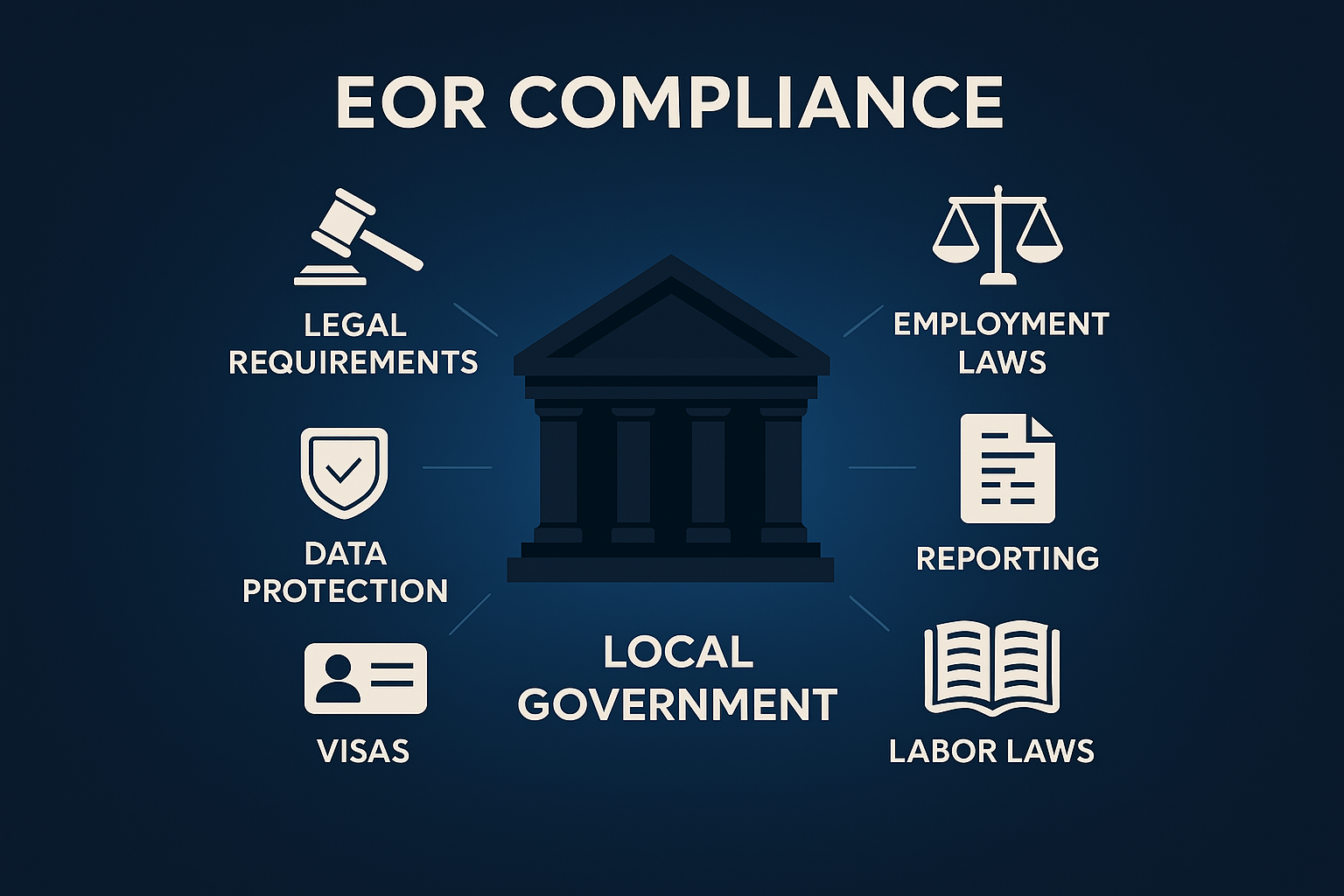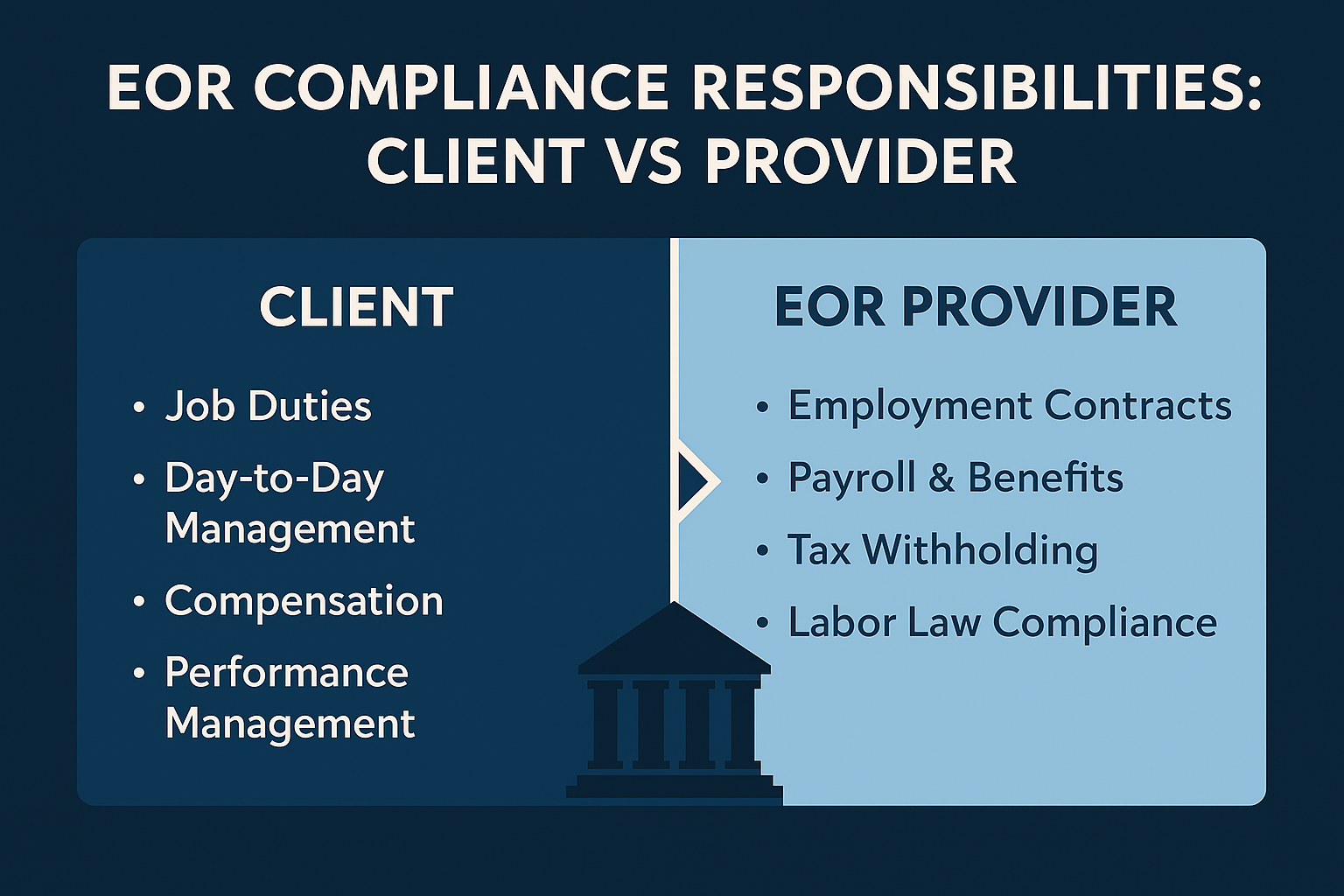Your first international hire triggers complex compliance obligations across labor laws, taxes, benefits, and data protection, and one missed filing or misclassification can cost more than the hire itself.
EOR compliance covers the legal responsibilities an Employer of Record takes on as the statutory employer, but there are still areas you’re accountable for and critical due diligence questions teams often overlook until it’s too late.

Why Compliance Failures Cost More Than Fines?
EOR compliance covers everything required to legally employ someone in another country labor laws, taxes, social security, statutory benefits, contracts, data protection, and worker classification. But it’s not just about avoiding penalties.
In 2024, LinkedIn was fined €310 million under GDPR, showing that enforcement is only getting stricter.
The real damage goes deeper: non-compliance scares investors during due diligence, hurts your employer brand in competitive markets, and can trigger legal issues that freeze hiring or force costly restructuring. These ripple effects slow down global growth far more than any single fine.
This guide breaks down what a good EOR actually handles, what responsibilities still sit with you, and the key questions companies often forget to ask before they sign an EOR agreement.
What Compliance Responsibilities Does an EOR Actually Own?
An EOR doesn't just run payroll. It assumes legal employer status in the host country, holding statutory liability for employment practices within that jurisdiction. But this isn't a wholesale risk transfer.
How does an EOR work as the Legal Employer?
When you engage an EOR, it becomes the legal employer of record for tax and labor law purposes.
The EOR:
- Issues compliant employment contracts under local law
- Withholds and remits payroll taxes and social contributions
- Manages statutory benefits enrollment and contributions
- Holds liability for employment-related claims like wrongful termination, unpaid wages, and discrimination
Your company remains the functional employer. You control day-to-day work, performance management, and business decisions.
Which Compliance Obligations Still Belong to You?
This is where most companies miscalculate. Compliance is shared, not outsourced. You still own:
1. Work direction and performance management
How you structure roles, set KPIs, and manage performance can create co-employment exposure or trigger misclassification risk.
2. Data handling practices
Store employee data in non-compliant systems or share it with third parties without proper safeguards? You're liable.
3. Health and safety protocols
Limited protocols for remote workers, but critical in hybrid or office-based models.
4. Immigration and visa sponsorship decisions
EORs facilitate, but final accountability for work authorization often sits with the hiring entity.Your EOR contract doesn't protect you. It clarifies who gets blamed when regulators investigate
EOR Compliance Responsibilities: Client vs. Provider

To clarify exactly what an EOR handles versus what remains your responsibility, here's a breakdown:
How Do Employment Contracts, Payroll, and Tax Compliance Work Under an EOR?
When you hire internationally, the EOR’s biggest responsibility is making sure contracts, payroll, and taxes follow each country’s laws. This is where compliance failures happen fastest, so accuracy matters.
How Do You Ensure Contracts Meet Local Laws?
A compliant contract isn’t just a translated template; it must follow country-specific rules around notice periods, probation, severance, and termination, which vary widely across markets.
Gloroots solves this by generating fully localized contracts reviewed by local legal experts, ensuring you’re protected during audits, disputes, and regulatory checks.
What Ensures Accurate Payroll and Tax Withholding?
Payroll compliance goes far beyond paying people on time. Each country sets its own rules for tax withholding, benefit deductions, payslip formats, and statutory contributions.
Missing a tax deadline can trigger instant penalties, and an incorrect contribution amount can raise audit flags.
A compliant payroll process must include:
- On-time tax payments to local authorities
- Accurate social security and employer contribution calculations
- Payslips that meet country-specific line-item and language requirements
- Clear FX handling and records for audit trails
How Gloroots Automates Payroll & Tax Accuracy
Gloroots manages multi-country payroll through a single automated system that handles tax deductions, benefits, and local currency payouts. The platform spots issues before payroll runs like contribution caps, missing deductions, or inconsistent data so problems are fixed early instead of becoming audit risks.
You also get detailed invoices with country-level breakdowns and GL-ready exports, giving finance teams clean, audit-friendly documentation every month.
Why Are Benefits, Data Protection, and Worker Classification High-Risk Areas?
These zones see reputational damage compound financial penalties.
How EORs Handle Statutory and Voluntary Benefits?
- Benefits compliance isn’t just about offering health insurance.
- Each country sets mandatory rules for leave (annual, sick, parental), pension or retirement contributions, and required insurance like employer liability or workers’ compensation.
- Even optional benefits such as private health plans or wellness allowances must follow local tax rules and non-discrimination standards. Gloroots handles all of this by offering locally compliant, competitive benefits packages that meet legal requirements and help teams stay engaged and supported across countries.
How Data Protection Laws Impact EOR Compliance
Data privacy is mandatory now. GDPR in Europe, CCPA in California, LGPD in Brazil, PDPA in Singapore impose strict rules on how employee data is collected, stored, processed, and shared.
In fact, over 60% of major EOR compliance enforcement actions now involve multi-agency audits where data authorities coordinate with labor and tax regulators.
Your EOR must:
- Store data in compliant jurisdictions (data residency requirements)
- Implement encryption, access controls, and breach notification protocols
- Provide Data Processing Agreements (DPAs) that define liability
- Facilitate GDPR-style employee data requests for access, deletion, and portability
If your EOR uses subcontractors in unregulated jurisdictions, you inherit their data vulnerabilities. Ask:
- Where is employee data stored?
- Who has access?
- What certifications back their claims?
Avoiding Misclassification Penalties Through Expert Guidance
- Using an EOR helps companies avoid the legal risks that come from misclassifying employees as contractors, a problem regulators are cracking down on. Misclassification can lead to back taxes, heavy fines, and forced reclassification of similar workers.
- Each country uses its own tests to determine worker status, but they usually look at three things: who controls the work, who covers costs and sets pay, and whether the relationship is ongoing or purely project-based.
Gloroots makes it easy to shift contractors to full-time employees when needed, so you don’t accidentally create an employer relationship through long-term contractor use.
Immigration and Global Labor Law Compliance Across Regions
Labor law isn't monolithic. It's shaped by local norms, union agreements, and enforcement priorities that shift by region.
What Visa and Work Permit Support Do EORs Provide?
- EORs manage visa sponsorship, documentation, immigration coordination, renewal tracking, and right-to-work checks to ensure employees are legally authorized.
- They also handle cross-border compliance like tax residency and social security, while Gloroots adds India-specific support such as PF/ESIC/gratuity filings and local HR guidance.
How Do Local Labor Laws Differ by Geography?
- Labor laws differ greatly across countries, ranging from at-will employment to strict notice periods, termination rules, and working-hour limits, which impact hiring, payroll, and daily operations.
- An experienced EOR helps you stay ahead of these differences by anticipating local risks and guiding you toward practices that match each country’s legal and enforcement standards.
How Do Risk Management and Financial Transparency Set EORs Apart?
As the footprint expands, audit-ready documentation and financial clarity become non-negotiable.
How Should Transparent Invoicing Work?
- Your EOR should give you full financial transparency through detailed, country-level invoices, GL-ready accounting exports, and audit trails for every payroll and statutory payment, and Gloroots delivers exactly that, not vague monthly summaries.
Why Does Legal Liability Coverage Matter to Your Board?
- Reputable EORs carry Employment Practices Liability Insurance (EPLI) and maintain compliance reserves for statutory obligations. This isn't just risk transfer. It's proof the EOR has skin in the game and can cover penalties if they arise.
Why Compliance Functions as a Growth Lever
- Compliance isn't defensive. It's what lets you scale without friction.
- When your EOR infrastructure is audit-ready, you move faster on acquisitions, investor due diligence, and expansion into regulated markets.
- Board members and CFOs increasingly view global compliance infrastructure as a strategic asset, not HR overhead.
How EORs Maintain Ongoing Compliance as Regulations Change?
Regulations don't stay still. Employment laws, tax codes, and data privacy standards change constantly. Your EOR must keep pace.
Why Does Legal Liability Coverage Matter to Your Board?
- Top EORs stay ahead of regulatory changes by monitoring laws in real time, updating contracts and payroll proactively, running internal audits, and giving you dashboards that highlight risks before they become issues.
- Gloroots strengthens this with automation and dedicated Customer Success Managers who notify you about changes affecting your team—like new minimum wages, visa updates, or tax rule revisions.
Which Certifications Prove an EOR Meets Compliance Standards?
- Certifications aren't guarantees, but they signal investment in systems and processes.
- SOC 2 Type II validates data security and operational controls. ISO 27001 confirms information security management systems. GDPR and CCPA compliance programs demonstrate data protection governance.
How Can You Choose a Trusted, Compliant EOR Partner?
The cheapest EOR is rarely the most compliant. Here's what to verify before you sign:
1. Global entity coverage and licensing
Does the EOR own entities in your target markets, or rely on subcontractors? Subcontractor-based EORs introduce hidden vulnerabilities. You're trusting their partner's compliance, not theirs.
2. Transparent pricing and contract terms
Are costs broken out by category or lumped into opaque monthly rates?
Hidden fees show up in invoices, not proposals.
3. Verified compliance frameworks
Ask for proof: entity registration documents, tax filing receipts, recent audit reports. Documentation matters more than promises.
4. Data security and audit readiness
Ask: Where is employee data stored? Who has access? What happens in a breach? These aren't hypothetical questions. They're board-level liabilities.
5. Proven track record
Case studies, client references, tenure in complex markets like India, Brazil, Germany reveal whether the EOR has navigated enforcement actions and come out clean.
Discover how Gloroots simplifies compliance across 100+ countries with owned entities, transparent invoicing, dedicated support that scales with your team.
Why Strong EOR Compliance Is Key to Long-Term Global Expansion?
- Compliance may not be exciting, but it’s what makes global hiring stable and scalable.
- When your employment setup is audit-ready, you can hire faster without legal bottlenecks, and investors gain confidence during due diligence.
- Avoiding even one major penalty or data breach often saves more than the total cost of using an EOR. Companies that treat compliance as a strategic advantage, not a checkbox, scale faster. They hire better talent. They sleep better at night.
Gloroots' platform plus managed service model combines self-service dashboards with hands-on compliance guidance, automation where it matters, expert judgment where it doesn't.
FAQs: EOR Compliance Responsibilities
1. Who holds liability when local labor laws are violated?
The EOR takes statutory liability for payroll, benefits, and labor law compliance as the legal employer. But you can still face penalties for co-employment issues, misclassification, or data breaches that stem from your own practices.
2. How often do labor and tax laws change, and how do EORs adapt?
Labor laws shift constantly—minimum wages, tax codes, data mandates can update monthly in some countries. Gloroots monitors these changes in real time and alerts you through dedicated Customer Success Managers before they affect your team.
3. What data security standards should an EOR follow?
Your EOR must comply with GDPR, CCPA, PDPA, and other local data laws in every country you hire. Look for SOC 2 Type II and ISO 27001 certifications, ask where data is stored, and confirm they use Data Processing Agreements.
4. What's the difference between EOR and PEO compliance responsibilities?
A PEO co-employs workers with your existing entity and shares compliance duties. An EOR becomes the sole legal employer in countries where you have no entity, handling full statutory liability independently.
5. Can companies audit their EORs' compliance processes and documentation?
Absolutely, and you should. Request entity registrations, tax receipts, audit reports, and sample contracts during due diligence.Gloroots offers detailed financial visibility and audit-ready exports to support your internal and external compliance reviews.

.webp)




























.webp)























.webp)


.webp)


.webp)






